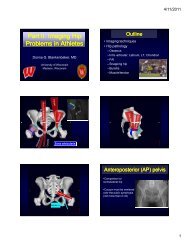Ankle and Foot 47 - Department of Radiology - University of ...
Ankle and Foot 47 - Department of Radiology - University of ...
Ankle and Foot 47 - Department of Radiology - University of ...
Create successful ePaper yourself
Turn your PDF publications into a flip-book with our unique Google optimized e-Paper software.
2230 VII Imaging <strong>of</strong> the Musculoskeletal System<br />
dental findings, in rare circumstances they are painful<br />
normal variants, conditions that can be difficult to diagnose<br />
<strong>and</strong> difficult to treat.<br />
Figure <strong>47</strong>-31. The normal medial ankle ligaments on a T1-weighted<br />
image obtained using a high-resolution 512 acquisition matrix. This<br />
coronal image is located just behind the middle facet <strong>of</strong> the subtalar<br />
joint. (This image is seven slices anterior to Fig. <strong>47</strong>-29D). The<br />
magnified dashed box to the right shows the superficial <strong>and</strong> deep<br />
components <strong>of</strong> the deltoid ligament. The broader deep fibers (black<br />
arrow) run from the medial malleolus (MM) to the medial process <strong>of</strong><br />
the talus. The more slender superficial fibers (white arrow) run from<br />
the MM to the calcaneus at the sustentaculum tali (ST). Also shown is<br />
the flexor retinaculum (open arrowheads), forming the ro<strong>of</strong> <strong>of</strong> the<br />
tarsal tunnel atop the three medial tendons (T, posterior tibial; D,<br />
flexor digitorum longus; H, flexor hallucis longus) <strong>and</strong> the posterior<br />
tibial neurovascular bundle (dotted oval).<br />
• Os Trigonum Syndrome<br />
The os trigonum is a common accessory ossicle located<br />
directly behind the talus, at the posterior end <strong>of</strong> the<br />
subtalar joint, adjacent to where the flexor hallucis longus<br />
wraps around the back <strong>of</strong> the talus. The os trigonum develops<br />
as a separate ossification center. During growth this<br />
fuses to the talus in most people, but in 5% to 15% <strong>of</strong><br />
normal feet it remains nonunited <strong>and</strong> is variable in size<br />
<strong>and</strong> shape. There are no radiographic findings in a patient<br />
with symptomatic os trigonum syndrome, 44 although the<br />
diagnosis can be made with MRI by demonstrating marrow<br />
edema in the os trigonum <strong>and</strong> the adjacent talus<br />
(Fig. <strong>47</strong>-33).<br />
• Accessory Navicular Syndrome<br />
The accessory navicular bone (os tibiale externum) is a<br />
common normal variant found adjacent to the medial pole<br />
<strong>of</strong> the navicular in approximately 10% <strong>of</strong> the population.<br />
As previously mentioned under “Medial Tendons,” the<br />
medial pole <strong>of</strong> the navicular is the primary insertion site<br />
<strong>of</strong> the posterior tibial tendon (see Figs. <strong>47</strong>-10D <strong>and</strong><br />
<strong>47</strong>-11C). Small accessory navicular bones are called type 1<br />
<strong>and</strong> are simply sesamoid bones in the substance <strong>of</strong> the<br />
posterior tibial tendon (Fig. <strong>47</strong>-34). The posterior tibial<br />
tendon still inserts normally on the navicular, <strong>and</strong> the type<br />
1 accessory navicular bones are <strong>of</strong> no clinical significance.<br />
Larger accessory navicular bones are called type 2 (Fig.<br />
<strong>47</strong>-35), <strong>and</strong> with these the posterior tibial tendon inserts<br />
onto the accessory navicular, rather than on the navicular<br />
Figure <strong>47</strong>-32. Deltoid ligament sprain in an 18-yearold.<br />
Mortise coronal T1-weighted (A) <strong>and</strong> T2-weighted<br />
fat-suppressed (B) images show abnormally increased<br />
signal in the deep deltoid (black arrow). There is bone<br />
marrow edema at its insertion site on the medial talus<br />
(arrowhead). The superficial deltoid (white arrow) is<br />
intact.<br />
A<br />
B<br />
Ch0<strong>47</strong>-A05375.indd 2230<br />
9/9/2008 5:34:01 PM
















